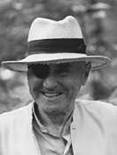William Segal

William Segal (1904-2000) demonstrated a versatile approach to life, being a visual artist, a poet, a follower of Gurdjieff and of Eastern spiritual traditions and aesthetics, as well as a self-made practical businessman. He was born in Georgia and moved to New York City with his parents. Starting off as an artist, after his marriage in 1928 he began work in trade publishing. He studied with Gurdjieff in the 1940s, during the latter’s trips to the United States, after which he remained a devoted adherent of his teaching. He also studied with Soen Roshi, Paul Reps and Daisetsu Teitaro Suzuki, having made a number of trips to Japan to meet them. He was influenced upon a Zen approach to life and art by his mentors. He fulfilled his artistic calling by his paintings and drawings, in many of which he demonstrated his spiritual search for the Essence and the Absolute Self. He also drew inspiration from the Upanishads, the Old and New Testament, Meister Eckhart and Shakespeare. Segal was prominent in the field of book and magazine design, similarly to Alexey Brodovitch or Alexander Lieberman, and his innovations in design exerted a great influence on fashion magazines in the 1940s and 1950s. He was the founder and managing director of Reporter Publications in New York City, and also a writer, editor, publisher and art director of the magazines issued by this publishing house, dealing with men’s fashion, fine art and commercial textile manufacture – Men’s Reporter, American Fabrics and Gentry. In these magazines he published articles on Zen Buddhism, Eastern art, falconry and modern painting. Segal is not very well known in design annals because he kept a low profile and hired designers to carry out his artistic plans. Segal synthesized Gurdjieff’s teachings with Hinduist, Buddhist and Zen traditions, frequently comparing Gurdjieff to a Zen master, as he did in his article “The Patriarch goes West,” published in the Gurdjieff International Review. He displayed his profound adherence to these spiritual traditions in his works of art and design and in his life. He wrote an autobiography, Voice at the Borders of Silence: The Autobiography of William Segal, An Intimate View of the Gurdieff Work, Zen Buddhism and Art, which demonstrates his rootedness in the Gurdjieff and Zen traditions.
Articles:
Quotations:
From Wm. Segal by Daniel L. Hess:
«The cultivation of a capacity for attention is probably the most important thing a human being can do, because with developed attention one can come closer to knowing who one is, to knowing the truth about the fantasy of life around us. With attention, a world uncovers itself.
I think with attention, one can lead a creative life as a human being. With attention, one experiences the world as richer, more fascinating, more meaningful; without attention we are victimized, and we victimize others. We are “things” instead of participants in the cosmic game.
Attention helps to bring about organization of energy and refinement of energy, otherwise there would be randomness in the universe as well as around one’s self.
When I am speaking to you, when I’m listening to you, I hope that I’m related and linked to an element of vibration which is equivalent to what one is related to when one sits in meditation. So there is no difference. There is the form and the non-form, which are both in some paradoxical way, one and the same thing.»
————-
As a painter, how do you see the connection between art and meditation?
«The question may be one relating to awakedness. The relationship is the same as when one chops wood or drinks a cup of coffee—one is awake or asleep in the sense of an inner relationship. Great art, like great music or poetry, is a tribute to the human spirit.»
«To love the reality, not the illusion of reality, would mean love based on a realization that you and I are the same. My suffering is your suffering and your suffering is my suffering. With love between the sexes based on that realization, there would be attenuation of the ego-centrism that spoils all relationships.»
“One attribute of the human being is the potential to keep on growing, to keep on developing. And I think there’s room in each of us. I hate to hear someone say, oh well, that man or that woman is sixty or seventy or eighty or ninety or a hundred, so he’s finished. There’s always something that can be transformed on the upward spiral.”
An Excerpt from A Voice at the Borders of Silence: The Autobiography of William Segal by William Segal with Marielle Bancou-Segal, edited by Mark Magill:
“With sustained attention, one grasps relationships which usually are overlooked. So how to nurture an attention which penetrates into the heart of things? It’s an interesting subject, to speculate that with attention. Whole new worlds reveal themselves. The Chinese and Japanese artists have understood for a long time the importance of being ‘still,’ of gathering their energies for a few moments before beginning.”
“Instead of a headlong rush, which is fine for a while, one has to step back. This stepping back is difficult, especially when one is on a roll. In painting, as in other pursuits, when all is going well one wants to keep going… That’s fine, but sometimes a pause, stop, stepping back and looking brings the unexpected.”
“Moments of stillness align one’s forces. When man’s energies are together in balance, more is possible than when they are random, dis-equilibrated. Heart and feeling are needed as well as the intellect. Concentration, attention is the key in any endeavor, whether building a brick wall, working with a computer program or painting a picture.”
The sourses:
http://www.gurdjieff.org/segal2.htm
http://www.gurdjieff.org/hess1.htm
http://www.spiritualityandpractice.com/books/excerpts.php?id=14400





